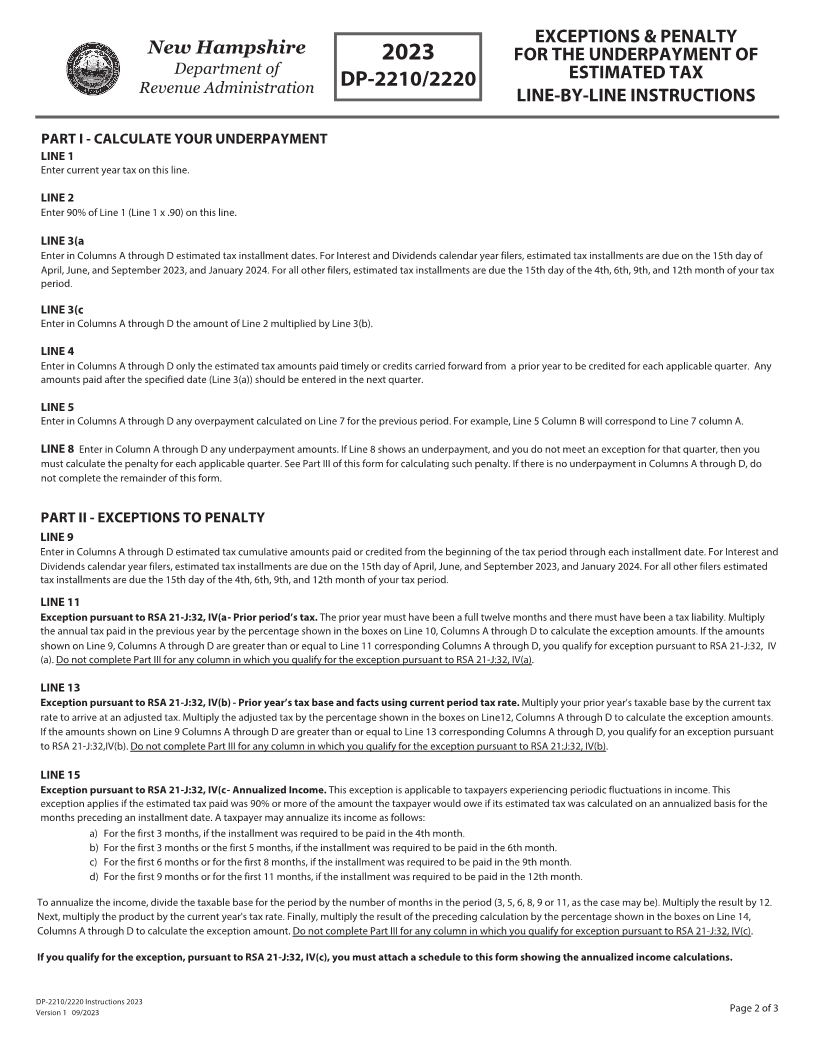
Enlarge image
EXCEPTIONS & PENALTY
New Hampshire
2023 FOR THE UNDERPAYMENT OF
Department of
ESTIMATED TAX
Revenue Administration DP-2210/2220
GENERAL INSTRUCTIONS
CONFIDENTIAL INFORMATION
Tax information disclosed to the New Hampshire Department of Revenue Administration is held in strict confidence by law. The information may be disclosed to the
United States Internal Revenue Service, agencies responsible for the administration of taxes in other states in accordance with compacts for the exchange of
information, and as otherwise authorized by RSA 21-J:14.
TAXPAYER IDENTIFICATION
The Commissioner of the Department of Revenue is authorized pursuant to RSA 21-J:27-a to require submission of an SSN, FEIN, or any other identifying number used
in filing or preparing federal tax documents. If you do not have any such identifying number, or share one with another taxpayer, then, under Rev 2903.01, you must
obtain a Department Identification Number (DIN). If you have a DIN, use it on all New Hampshire filings. To ensure that your filings and payments are applied to the
correct account, the sequence of names and taxpayer ID numbers on all filings must be consistent. The failure to provide a taxpayer identification number may result in
the rejection of filed documents. Failure to timely file documents complete with a consistent taxpayer identification number may result in the imposition of penalties
and interest, the dis-allowance of claimed exemptions, exclusions, credits, deductions, or an adjustment that may result in increased tax liability.
Enter the taxpayer's name and taxpayer identification number in the spaces provided.
Enter the beginning and ending dates of the taxable period.
NOTE: If the Interest and Dividends Tax for the current taxable period is less than $500 do not complete this form. For taxable periods ending on or after
December 31, 2013, do not complete this form if BPT is less than $200 or BET is less than $260. Do not complete this form if you were not required to file a return in the
previous taxable period. If you made late partial estimated tax payments, or if this form does not adequately provide instructions for payments you have made, contact
Taxpayer Services at (603) 230-5920. Individuals who need auxiliary aids for effective communications in programs and services of the New Hampshire Department of
Revenue Administration are invited to make their needs and preferences known. Individuals with hearing or speech impairments may call TDD Access: Relay NH
1-800-735- 2964.
NEED FORMS?
To obtain additional forms, you may visit our website at www.revenue.nh.gov or call the Forms Line at (603) 230-5001.
NEED HELP?
Call the Department of Revenue Administration, Taxpayer Services at (603) 230-5920. Individuals with hearing or speech impairments may call TDD
Access: Relay NH 1-800-735-2964.
DP-2210/2220 Instructions 2023 Page 1 of 3
Version 1 11/2023

